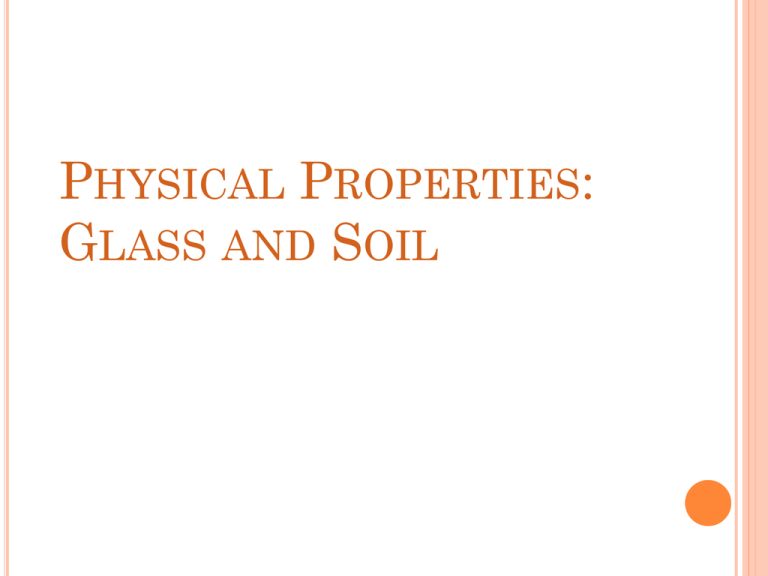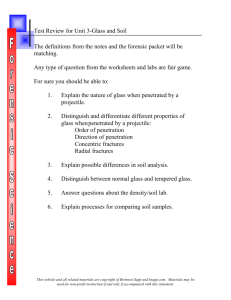P : G S
advertisement

PHYSICAL PROPERTIES: GLASS AND SOIL Physical property: describes the behavior of a substance without having to alter the substance’s composition through a chemical reaction Chemical property: describes the behavior of a substance when it reacts or combines with another substance Weight: a property of matter that depends on the mass of a substance and the effects of gravity on that mass Mass: a constant property of matter that reflects the amount of material present Density: a physical property of matter that is equivalent to the mass per unit volume of a substance Refraction: the bending of a light wave as it passes from one medium to another Refractive index: the ratio of the speed of light in a vacuum to its speed in a given substance Crystalline solid: a solid in which the atoms have a regular arrangement Amorphous solid: a solid in which the atoms or molecules are arranged in random or disordered positions. There is no regular order. Birefringence: a difference in the two indices of refraction exhibited by most crystalline materials Dispersion: the separation of light into its component wavelengths Becke line: a bright halo that is observed near the border of a particle immersed in a liquid of different refractive index Radial fracture: a crack in a glass that extends outward like the spoke of a wheel from the point at which the glass was struck Concentric fracture: a crack in a glass that forms a rough circle around the point of impact Density-gradient tube: a glass tube filled from bottom to top with liquids of successively lighter densities Physical Evidence: Glass and Soil Analysis PROPERTIES OF MATTER Chemical Properties a characteristic of a substance that describes the way the substance undergoes or resists change to form a new substance Physical Properties a characteristic of a substance that can be observed without changing the substance into another substance PHYSICAL PROPERTIES Extensive (extrinsic) Properties depend on the amount of sample volume, mass Intensive (intrinsic)Properties do not depend on the amount of sample melting point, density Metric System • In 1791, the French Academy of Science devised the simple system of measurement known as the metric system. • The metric system has basic units for length, mass, and volume. • These units are the meter, gram, and liter. ____________________________________________________ • Volume can be defined in terms of length • A liter by definition is the volume of a cube, each side having a length of 10 centimeters. • One liter is therefore 10 cm x 10 cm x 10 cm – 1 liter = 1,000 cubic centimeters (cc) – 1 liter is also 1,000 mL – Therefore, 1mL =1cc. These terms are used interchangeably by scientists. Physical Properties The temperature at which a substance melts or boils will help identify a substance. What is temperature? How is temperature measured? Temperature is the amount of heat in an object. In the Fahrenheit scale, the values are 32 °F and 212 °F In the Celsius scale, the values are 0 °C and 100 °F Weight and Mass What is the difference between weight and mass? Weight is the force with which gravity attracts a body. Mass refers to the amount of matter an object contains. The mass of an object is determined by comparing it against the known mass of standard objects. DENSITY An important physical property of matter with respect to the analysis of certain kinds of physical evidence An intensive property of matter. Defined as mass per unit volume. Typically measured in g/mL or g/cm3 Varies by temperature Physical Measurements Electromagnetic radiation (light): Composed of waves The waves transport energy as photons Wavelength and Frequency are inversely proportional Travels at 3 x 108 m/s in a vacuum speed of light = wavelength x frequency (c = ln) Light Facts: Light travels more slowly in media The change of wavelength at the surface between different media causes light passing to be bent called refraction Waves of different frequencies bend at different angles; the results being that the light is dispersed Refraction Dispersion REFRACTION The bending that occurs when a light wave passes at an angle from one medium to another (ex. air to glass) bending occurs because the velocity of the wave decreases The Refractive Index (RI) is a highly distinctive property of glass and is useful for evidential value. The physical properties of density and refractive index are most widely used for characterizing glass particles. Snell’s Law: n1 = refractive index of 1st medium n2 = refractive index of 2nd medium Ө1 = angle of incidence between incoming ray and normal line Ө2 = angle of incidence between outgoing ray and normal line The refraction index of a substance is equal to c (the speed of light in space) divided by the speed of light in that particular substance. Substance Air Ice Water Ethyl Alcohol Quartz Salt Tourmaline Garnet Cubic Zirconium Diamond State Gas Solid Liquid Liquid Solid Solid Solid Solid Solid Solid Refractive Index 1.000293 1.31 1.33 1.36 1.54 1.54 1.62 1.73-1.89 2.14 - 2.20 2.41 • Almost all refractive indices are determined at wavelength of 589.3 nm (predominant wavelength emitted by sodium light) BIREFRINGENCE The difference between the two indices of refraction for calcite: 1.486 & 1.658 birefringence = 0.172 Use in identifying crystals DISPERSION GLASS The Basics WHAT IS GLASS? One of the oldest of all manufactured materials A simple fusion of sand, soda & lime An extended, network of atoms which lacks the repeated, orderly arrangement typical of crystalline materials The viscosity is such a high value that the amorphous material acts like a solid STRUCTURE OF GLASS PHYSICAL PROPERTIES At ordinary temp. internal structure resembles a fluid random molecular orientation external structure displays the hardness & rigidity of of a solid Does not show a distinct melting point on heating gradually softens on cooling gradually thickens TYPES OF GLASS More than a thousand chemical formulations each has its own combination of properties Most common type encountered by the forensic scientist is “flat” glass used in windows & doors Comparing Glass Fragments Composed of silicon oxides mixed with metal oxides Soda-lime glass Soda (NaCO3) Lime (CaO) windows bottles Pyrex Borosilicates use Boron oxide, Can Test tubes withstand HIGH heats Headlights Tempered Glass: Rapid heating and cooling does not shatter Shower doors Side + rear windows Laminated Glass Plastic or Glass and glues and sandwich windshields Float (Plate) glass: molten glass is cooled on a bed of tin; typically used for windows. Tempered glass: stronger than ordinary window glass by introducing stress through rapid heating and cooling of the glass surfaces. • When tempered glass breaks, it does not shatter but fragments or dices into small squares with little splintering. • Commonly used in side and rear windows of automobiles. Laminated glass: made by sandwiching one layer of plastic between two layers of glass. • Found in car windshields. Plate Glass Tempered Glass Laminated glass GLASS AS FORENSIC EVIDENCE Physical properties can be used to place glass into a class Density Refractive Index (RI) Elemental composition Individualization can’t be determined from these properties alone FLOTATION TEST Based on density comparison A control glass chip (known density) immersed in a liquid (often a mixture of bromoform & bromobenzene) composition altered until the chip remains suspended The crime object (glass of unknown density) immersed in the liquid mixture Remains suspended: liquid, control & unknown have same density Sinks: unknown is more dense than control different origins REFRACTIVE INDEX BY IMMERSION Entails finding the temperature at which a glass particle & a liquid have identical refractive indices refractive index of glass is relatively unaffected by changing temp Reason why the eye is unable to distinguish between the solid-liquid boundary. Becke Line . A bright halo that is observed near the border of a particle immersed in a liquid of a different refractive index When Becke line and glass disappears, index of refraction has been reached Glass has higher refractive index Becke line seen inside RI(glass) > RI(solvent) Glass has lower refractive index Becke line seen outside RI(glass) < RI(solvent) REFRACTIVE INDEX BY IMMERSION 1. 2. 3. Hot stage microscope used Glass is immersed in a liquid which has a higher RI than glass. Temperature is raised at rate of 0.2 oC/min until Becke line disappears. Rate of change of RI in liquid is known. The point where the Becke line disappears: RI of the sample = the RI of the liquid If all glass fragments have similar match points, they have comparable Refractive Indices GRIM3 Glass Refractive Index Measurement Instrument used for measuring refractive index of glass fragments ELEMENTAL ANALYSIS Many trace elements enter glass via trace impurities in the raw materials Comparison of elemental analysis of crime glass & reference glass if ranges of elements overlap for every element indistinguishable if ranges of one or more elements are different samples are distinguishable Glass Fracture Analysis Sometimes a fractured glass object can be reconstructed. Due to the vast number of ways a lens could break, a piece of glass fitting into each other for reconstruction would be considered identification CHE 113 36 GLASS FRACTURE EXAMINATION Occurs when the limit of its elasticity is reached • Gives information relating to force and direction of an impact • Two types: • Radial fractures – cracks radiate outward and encircle hole like spokes of a wheel • Concentric fractures – circular lines form a rough circle around point of impact • Glass Fractures Sequence: 1. 2. Radial cracks are formed on opposite surface Continued force on surface causes concentric cracks on surface side of the force. Impact causes a pane of glass to bulge Side opposite the impact will stretch more & rupture first Radial cracks are rapidly propagated in short segments from the point of impact Glass Fractures: GLASS ANALYSIS Ridges on radial cracks can be used to determine on which side impact occurred Stress marks left on broken edges of glass are perpendicular to one side and curve (run almost parallel) to the other side THREE “R” RULE Ridges (on radial cracks) are at Right angles to the Rear (side opposite the impact) THREE “R” RULE Exceptions tempered glass very small windows held tightly in frame “dices” without forming ridges can’t bend or bulge appreciably windows broken by heat or explosion no “point of impact” FRACTURES CAUSED BY PROJECTILES Close Range shot Leaves a round, crater shaped hole surrounded by a nearly symmetrical pattern of radial and concentric cracks Hole is wider at exit side providing a means of determining direction of impact High-velocity projectiles crater-like hole surrounded by a nearly symmetrical pattern of radial and concentric crack FRACTURES CAUSED BY PROJECTILES BULLET ANALYSIS If a window is broken by a bullet, it is possible to determine the bullet's direction by noting the side of the cone-shaped hole left by the bullet. The small opening is on the entrance side and the large opening is on the exit side. A determination of the sequence of bullet holes can be made by noting the radial fractures. Radial fractures caused by the passage of a bullet will stop at any pre-existing fracture. Soil Analysis Forensic Characteristics of Soil Soil includes any disintegrated surface material, that lies on or near the earth’s surface Value based on prevalence at crime scenes and ability to transfer between scene and criminal Most soils can be differentiated and distinguished by appearance • visual comparison What Is Soil? Mixture of organic and inorganic material Inorganic part contains minerals Organic part is decayed plant and animal material and is sometimes called humas Soil Analysis Soil is darker when wet. Therefore, color comparisons must always be made when all the samples are dried under identical laboratory conditions. There are an estimated 1,100 distinguishable soil colors. There are at least 50,000 different soil types in the United States alone. Low-power microscopic examination reveals the presence of plant and animal materials as well as artificial debris. SOIL ANALYSIS Bulk analysis Density gradient Particle size distribution (sieve) Inorganic components Color (dissolve in water) Mineral analysis Organic components Oxygen availability Soil comparison: Density Gradient tube used to compare soil samples 1.0 g/ml 1.5 g/ml SOIL




